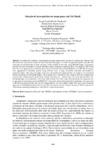Use este identificador para citar ou linkar para este item:
http://www.alice.cnptia.embrapa.br/alice/handle/doc/1035217Registro completo de metadados
| Campo DC | Valor | Idioma |
|---|---|---|
| dc.contributor.author | EBERHARDT, I. D. R. | pt_BR |
| dc.contributor.author | LUIZ, A. J. B. | pt_BR |
| dc.contributor.author | FORMAGGIO, A. R. | pt_BR |
| dc.contributor.author | SANCHES, I. D. | pt_BR |
| dc.contributor.author | SCHULTZ, B. | pt_BR |
| dc.contributor.author | TRABAQUINI, K. | pt_BR |
| dc.date.accessioned | 2016-01-26T11:11:11Z | pt_BR |
| dc.date.available | 2016-01-26T11:11:11Z | pt_BR |
| dc.date.created | 2016-01-26 | pt_BR |
| dc.date.issued | 2015 | pt_BR |
| dc.identifier.citation | In: SIMPÓSIO BRASILEIRO DE SENSORIAMENTO REMOTO, 17., 2015, João Pessoa. Anais... São José dos Campos: INPE, 2015. p. 5650-5657. | pt_BR |
| dc.identifier.uri | http://www.alice.cnptia.embrapa.br/alice/handle/doc/1035217 | pt_BR |
| dc.description | Abstract: Nowadays the challenge in agricultural estimates using remote sensing is to produce the estimates and data across the crop season, in near real-time. The aim of this paper is to build an approach capable to produce the crop maps of soybean+maize in near real-time, for Rio Grande do Sul state, using MODIS images. To generate the near real-time crop maps we used the MODIS 16 days composites vegetation index (VI) images of NDVI and EVI. This new approach was called Near Real-Time Crop Fields Detection (DATQuaR). The MODIS VIs images were aggregated in bimonthly periods using different ways: average, maximum, minimum and median of registered values. After that, the image of the previous period was subtracted from the image of the monitored period, generating the DATQuaR images. These images were classified by slice using as limit the occupied area estimate with soybean+maize produced by random sampling over Landsat image and visual interpretation. The DATQuaR maps were submitted to 3x3 pixel window mode filter. The results showed that the best approach was to aggregate the maximum registered MODIS IVs value in the monitored period and the minimum value registered in the previous period. In this case the EVI images and the 3x3 pixel window mode filterwere used. Using this approach the DATQuaR method achieved over 81% (in the worst period, January/February of 2014) of agreement with random sampling Landsat pixels classified by visual interpretation. | pt_BR |
| dc.language.iso | por | pt_BR |
| dc.rights | openAccess | pt_BR |
| dc.subject | Mapas de cultivo de verão | pt_BR |
| dc.subject | MODIS | pt_BR |
| dc.subject | DATQuaR | pt_BR |
| dc.title | Detecção de áreas agrícolas em tempo quase real (DATQuaR). | pt_BR |
| dc.type | Artigo em anais e proceedings | pt_BR |
| dc.date.updated | 2016-01-26T11:11:11Z | pt_BR |
| dc.subject.thesagro | Sensoriamento remoto | pt_BR |
| dc.subject.thesagro | Estatística agrícola | pt_BR |
| dc.subject.nalthesaurus | Remote sensing | pt_BR |
| dc.subject.nalthesaurus | Statistics | pt_BR |
| riaa.ainfo.id | 1035217 | pt_BR |
| riaa.ainfo.lastupdate | 2016-01-26 | pt_BR |
| dc.contributor.institution | ISAQUE DANIEL ROCHA EBERHARDT, INPE; ALFREDO JOSE BARRETO LUIZ, CNPMA; ANTONIO ROBERTO FORMAGGIO, INPE; IEDA DEL'ARCO SANCHES, INPE; BRUNO SCHULTZ, INPE; KLEBER TRABAQUINI, INPE. | pt_BR |
| Aparece nas coleções: | Artigo em anais de congresso (CNPMA)  | |
Arquivos associados a este item:
| Arquivo | Descrição | Tamanho | Formato | |
|---|---|---|---|---|
| 2015AA005.pdf | 551,46 kB | Adobe PDF |  Visualizar/Abrir |









